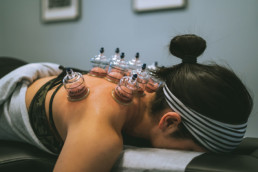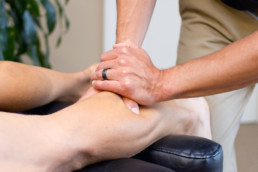Myofascial Cupping
From Olympic athletes to pregnant pop-stars, people are rediscovering the benefits of this ancient treatment. Myofascial Cupping is one of the oldest forms of medical treatment available today. Originating in Eastern China and Africa, this method of treatment is chosen to relieve pain and tension in the body using negative pressure to gently lift the skin of cups.

Active Release Techniques may help the body...
Improve Function
Relaxes muscular tension, improves range of motion, desensitizes nerves and soft tissue structures.
Reduce Inflammation
Improves localized circulation, reduces inflammation, and aids in lympathatic drainage.
Drug-Free Pain Relief
Decreases pain intensity and pain perception quickly and effectively.
What is Myofascial Cupping?
Myofascial cupping is a soft tissue modality that uses negative pressure to gently lift the skin and underlying connective tissue. When cups are applied to the skin, the tissue is drawn up into the cup. This decompression increases localized circulation, relaxes soft tissues, and is thought to stimulate healing.
Dynamic cupping follows a similar process, but rather than leaving the cup on one area of the skin, the therapist glides cups along the tissue with a similar intent to IASTM / Graston Technique. In addition, both static and dynamic methods can incorporate active movement to address faulty movement patterns and improve myofascial tissue glide.
Chinese cupping dates back to 28AD.
Physiologic Benefits
Increase Range of Motion
Research shows that ART treatments can help improve range of motion and mobility in those with musculoskeletal disorders or following injuries (acute trauma) and episodes of chronic pain.
One study published in the Journal of Physical Therapy Science demonstrated significant changes in range of motion compared to the control group. The ART group was found to produce greater improvements overall in several of the markers compared to the control group.
Pain Relief
Several studies demonstrate that Active Release Techniques can reduce pain intensity and pain pressure thresholds post treatment.
One study conducted by the Korean Academy of Physical Therapy Rehabilitation Science found that ART helps lower symptoms of lower back pain, considered to be one of the leading sources of dysfunction among adults.
Reduces Nerve Entrapments
A study published in the Journal of Chiropractic Medicine suggest that Active Release Techniques can be an effective treatment strategy for patients with carpal tunnel syndrome, which results in limited hand mobility and often swelling or pain due to nerve compression. Following treatment, patients reported significant improvements in symptom severity and showed increases in functional status scores compared to the start of the study.
Mitochondrial Support
HBOT allows mitochondria, the batteries of our cells, to generate adenosine triphosphate, or ATP. ATP is the chemical that stores and releases energy necessary for many cellular processes and is the main energy source for our body. When you have experienced cellular damage and oxygen-carrying capacity is threatened, your body is in jeopardy of not creating enough ATP. By providing high levels of oxygen, HBOT helps optimize cellular energy production.
Neovascularization
Hyperbaric oxygen therapy stimulates the growth of new blood vessels in the body, which increases circulation, allowing revitalized tissue to thrive even after the treatment protocol has been completed.
Stem Cell Mobilization
During treatment, HBOT has the power to increase stem cells in circulation eight-fold. These stems cells already exist in the body and have the unique ability to differentiate into any type of tissue, making them a valuable tool for regeneration and healing.
What Conditions Will Benefit?
ART treatment is effective against signs and symptoms of muscle and nerve dysfunction – sometimes referred to as soft-tissue conditions or MSDs – including tightness, pain, tingling, inflammation, restricted range of motion, muscle ache, and related symptoms.
- Arthritis
- Sports Injuries
- Neck Pain (Cervical Sprain / Strain)
- Back Pain (Lumbar Sprain / Strain)
- Knee Pain (Patellofemoral Disorders)
- Ankle Pain (Achilles Tendinitis)
- Foot Pain (Plantar Fasciitis)
- Shoulder Pain (Rotator Cuff Tendinitis)
- Tennis Elbow (Lateral Epicondylitis)
- Golfer’s Elbow (Medial Epicondylitis)
- Wrist Pain (Carpal Tunnel Syndrome)
- IT Band (Iliotibial Band)
- Repetitive Stress Injuries
- Muscle Strains
- Ligament Sprains
- Shin Splints

Learn More About Myofascial Cupping
What to Expect During Treatment
Treatment sessions last about 15-minutes and many patients experience dramatic reduction in pain and increase in range of motion after their first treatment.
How Many Treatments Are Recommended?
How many sessions a person needs depends on the severity of the health concern. While many people may benefit from a single session, often times more complex conditions may require more frequent treatment.